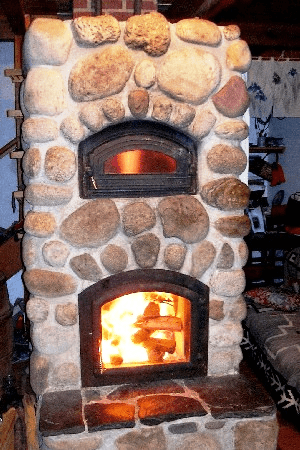
My friend Greg Kohler calls this "The Fire Channel." We never get tired of it. Fire roars through the bake oven on top (really cool). After the wood has burned to coals, you can bake in the oven. The hot combustion gases first go up, then all the way back down along the sides through heat exchanger channels and finally up the chimney (in back).
Masonry Stove Index
- Intro
- Disadvantages: I love my stove but know what you're getting into.
- Operating Tips: "little" details that make all the difference
- Visiting or Talking to People who Have Masonry Stoves: a mighty good idea
- The Kind I Have vs Other Designs: You have more choices than when I got mine
- Some Construction Details
- More Information/Links
- What Mark Twain Had to Say About Masonry Heaters
Intro
When I was building my house, I decided to install a northern European style masonry heater that differs from a typical wood stove in several ways:
- You load the fire box and burn it hot. Because the fire gets all the air it needs the combustion is very efficient with little smoke or creosote in the exhaust gases. Instead of going right up the chimney, the hot combustion gases follow a serpentine path and transfer heat to the walls of the masonry path they go through. Therefore, the fire lasts about an hour, but the heat soaked into the masonry mass radiates out for a day. It is a very even heat. We burn twice a day when it really gets really cold (does not get above freezing even during the day).
- Except for the metal and glass door, a masonry heater does not get dangerously hot. In fact, you can lean against it and get warm quickly. It is the next best thing to a hot shower.
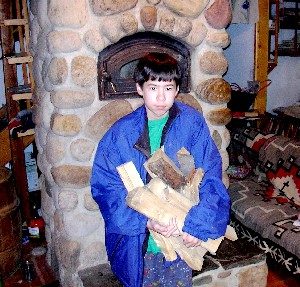
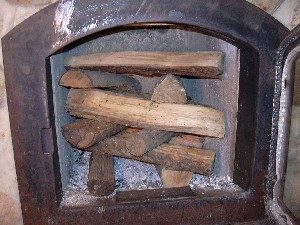
Disadvantages
After 14 years of depending on the masonry stove for all of my winter heat without problems, I cannot imagine returning to the noisy, unreliable furnaces that I used to have to deal with. However, the disadvantages or things to get used to are not lost on me.
- It takes up more space than a typical metal stove (“architectural feature” is the way one company put it.
- There is an up front investment of thousands of dollars just for the core. That does not include the foundation (the heater is very heavy), chimney--and skilled labor if you hire someone to install it. This is not one of those ready-made soapstone stoves that you plunk down anywhere. The core must be faced with a masonry material. I used river stone, and it was a lot of work. I do not have any backup heat, but most people would, and that would be an additional expense. I think the "rocket stove" movement might be a reaction to the high cost of traditional masonry stoves.
- The wood needs to be split and seasoned (dried out). This means keeping it out of the rain, too. Actually, any kind of wood stove should get dry wood. Masonry heaters work best if you select wood that's all roughly the same thickness. If you have a lot of skinny wood and one thick piece with knots, it's inefficient. The big piece that take's longer to burn will keep you from closing the chimney top (see f)) in a timely manner. Instead, try to select pieces of wood for a burn that you think will be burned at about the same rate. And even then, about half way through the burn you should use a long poker to drag any wood that's not burning fast to the front where the air intake is.
- As with the preceding item, this actually applies to all wood stoves, too: Chimneys that go up an outside wall--exposed on 3 sides to the outside cold air, in other words--are a bad idea. In particular regarding masonry stoves, the envelope of cold air they harbor makes starting a new fire difficult because it doesn't draw properly until the cold air is replaced with hot air. Having a chimney inside the house gives you a warm air envelope in the chimney ready to start drawing right away. The inside chimney adds to the efficiency, acts as a heat sink and radiates out more heat into the ho use.. Because the chimney is warmer, creosote from the exhaust gases are not as prone to condensing in the chimney. I have not had to clean the chimney in 10 years of use.
- It helps if your floor plan on the level that you have the heater is open, to distribute the heat. There are no big walls between our kitchen, dining room and living room. There is a closed off laundry room/ bathroom off in a corner of the house that is considerably cooler.
- This shocked me and shocks everyone when they first hear that the damper is closed when the fire has burned down to still-glowing embers, but I'm completely comfortable with it now. The kit came with a door for the TOP of the chimney. A long wire goes down through the chimney, out a tiny hole. You open the door with the wire just before you build a fire. Then you close the door after the fire has burned down to charcoal but before the charcoal has burned out. I had a carbon monoxide alarm and fretted about it at first, but no more. On average, 170 people die of non-automotive carbon monoxide poisoning in the U.S. alone--from defective coal or kerosene devices. Yet I cannot find even a single example on any any CO poisoning ever from a wood-fired masonry stove.
- My unit has an "air wash" glass door, which means the intake air to combust the wood rushes in from slots just above and just below the door. This keeps most of the smoke away from the glass, so we don't have to clean the glass door very often. However, the upper bake oven door does not have this feature and so blackens after a couple of burns. That said, I still like the bake oven. It's a bit messy but not hard to clean.
I bought a stainless steel coil and installed it in the heater to heat some of the domestic hot water (showers, laundry, dish-washing) for my family. To be practical, however, you really need a tank above (mine is on the second floor) so it can thermosiphon continuously by convection.
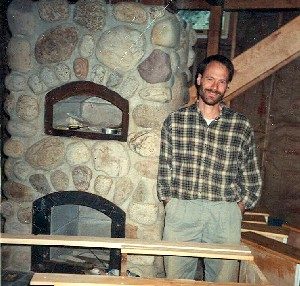
Here is a scratched picture from about 1998 when I was just finishing the stove, except for the doors. I was also making my own kitchen cabinets and drawers (seen scattered around). Both can be done as a do-it-yourself project, but neither is what you would call a "weekend project."
Operating Tips
("little" details that make all the difference)
I always open the chimney damper before loading the wood. So any ash dust that gets stirred up gets sucked up the chimney rather than drift into your house. Also have the damper open when you clean out ashes, for the same reason. Important: If possible, use similarly-sized wood in a batch for one burn so it will all burn in about the same amount of time. In other words, use all thin wood in one batch; use all thick/knotty pieces in another. If you don't do that, you'll tend to get one piece of wood that lags behind the other in burning, which is less efficient.
Light the fire. We don't even have to use kindling wood to get is started, just some balled up newspaper. But that's because we do things right: use dry wood, and our chimney is inside so we get air draw (suction of air up the chimney) right away. Some people start the fire on TOP of the stack of wood because it seems to make less smoke as the fire starts, but we're kinda lazy that way and just put the paper at the bottom.
When we first started using the stove, sometimes midway through the burn, the flaming, disintegrating wood pile would collapse and hit the glass door. I don't think there was ever much danger othe wood breaking the (tempered) glass--it didn't hit with much force--but it did damage the refracory ribbon that goes around the glass and seals it. Wood against the door also makes an awful mess on the glass; hard to clean. Avoiding that problem is not difficult but starts when cutting wood. Long pieces of wood tend to stick out close to the glass. Stacking the pile diagonally to the walls of the stove (rather than perpendicular and parallel to the walls) mitigates the problem of long wood somewhat. And if the wood pile is leaning, it should lean AWAY from the door, not toward it.Then, after your wood has burned for awhile and it looks like the pile might tip over and hit the door, use a poker to push the top of the stack toward the back.
When the pile of wood has collapsed--and even though the fire is really hot at this point (we have a really long poker), look for pieces of wood that are not burning as fast as the others. These might be at the bottom of the pile, toward the back and edges. If one piece of wood is thicker than the other or has knots, drag these pieces to where they will get a blast of air, which is in front on our stove. If you are in a hurry, hacking off the outside layer of charcoal with the poker speeds up burning, but you risk some pieces of glowing charcoal flying out and landing on the floor (I speak from experience).
The dampers of masonry stoves are closed when the fire has burned down to glowing embers (coals, charcoal) (see "f" above). You will know it's time where there is no more orange flame (blue, yes; orange, no). It is really important at this point to dig around with the poker--particularly in the corners and buried under ash--for smoldering, ends of wood that have not burned down completely to embers. When you drag these partly-burned chunks to the front, they will finish burning with an orange flame in a short time (they are finished when they too have a blue flame). It only takes a few seconds, but if you don't find and burn those chunks before closing the damper, they will continue to smolder for hours and stink up your house with an acrid, creosote smell. Again, I speak from experience. Because these stinkers hide in ash, I clean out the ash somewhat frequently--every week or so--so there's nowhere to hide.
I know this sounds like an awful lot of stuff to remember, but it's really not. It'll be natural and pretty effortless after the first burn or two.
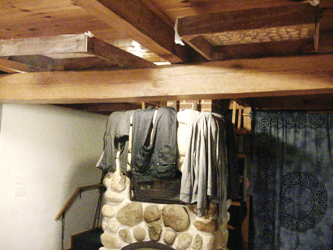
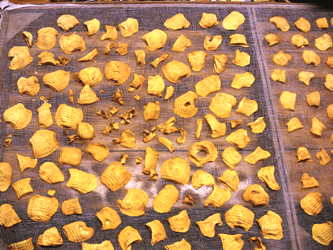
Visiting or Talking with Someone with a Masonry Heater
You are insane if you don't visit--or at least talk to--some people who have a masonry stove before committing to buy one. The businesses that sell and build them might be able to connect you with past customers. If you can travel to my house (in Williamsport, Pennsylvania up Bottle Run Road, 3 miles west of Lycoming Creek Road/ Route 15) I can show you my masonry heater. Assuming that you have read through this page, I'm happy to answer questions and go into details, either by phone or e-mail. It's not unusual for me to spend 20 minutes on the phone--which I'm happy to do--but I do not have free calling. So you will have to call me back if I'm not home--don't expect me to return long-distance calls. I'm Slater (rhymes with "later")
My Stove vs Other Designs
There are at least two ways to go about buying a masonry heater. I bought the core from a company in Toronto, Canada, and did all the rest of the work myself. Some people hire local masons then to build the foundation, chimney and facing, Tapcon the doors, in, etc. There are now enough masons in North America to build the heaters from scratch, on location with fire brick. I hear it takes about 3 days.
I have been reluctant to specify where I bought the core of my stove, but everybody asks, so here it is--good and bad. The company was TempCast. The reason I settled on Tempcast is because I wanted to do as much of the work as possible, yet I didn't feel confident to build one completely from scratch. At the time--in early 1990's--they were the only ones selling such a kit--large blocks that were keyed to fit together. It's likely the landscape has changed, so look around.
With the perspective of time, I am happy with the TempCast product, but there were some times I wondered if I had made a mistake. There was a perceptible difference from before, when I was a prospective customer; to after I had payed my money. When the core arrived, one of the giant 80 lb. blocks had broken in two. I documented it with the shipping person. I assumed it would be replaced, but John told me to just glue it together with refractory cement. I insisted on a replacement, but was forced to pay shipping of this 80 lb block from Canada. Then, when I assembled the stove, one block was misshapen. There was a huge gap and it rocked. Again John told me to just fill it with refractory cement. It was a clear manufacturing defect and he knew about it. I did fill it and it seems to be ok, but that and other things like it after I had paid my money left a bad taste.
That said, the instruction guide was clear enough that someone like me without a lot of masonry experience could make the footer, block wall, reinforced pad, assemble the blocks, face it, put the door in, etc. John did answer my construction questions. And it worked out well, Saves me over a thousand dollars a year in heat and I love it. Just look around and talk to lots of people before you plunk down your money. There are more options now that masonry stoves are becoming more common.
Some Construction Details
When I faced the core with rock, I first wrapped it with expanded steel lath to prevent cracking, and this worked. But I talked to another guy who faced with brick--no expanded metal behind--and crack opened up.
I ended up removing the rock wool from the top.
After a couple of years the wire to the upper chimney damper frays and breaks where it goes through the chimney wall. Better to leave it long, detach and move it a foot or so every couple of years before it breaks--it's a huge hassle to thread it through again.
More Information/ Links
Below are some good links about masonry heaters. And you can find other links there about cool related subjects like old fashioned, wood fired bake ovens. Lots of gorgeous photographs to drool over, too.
This Masonry Heater Association (MHA) is the place to start. Scroll down and you'll see the member directory with contact information that make up the association. And check out the beautiful gallery. I enjoyed reading about some of the member's work in a village in Guatemala with cook stoves.
This page is just sort of fun to see how they make a masonry bake oven--something I've always wanted to do. There are some good YouTube videos about this now.
This is a fantastic video that shows "What is a Flame?"
What Mark Twain had to say about masonry heaters :
“Take the German stove, for instance – where can you find it outside of German countries? I am sure I have never seen it where German was not the language of the region. Yet it is by long odds the best stove and the most convenient and economical that has yet been invented.
To the uninstructed stranger it promises nothing; but he will soon find that it is a masterly performer, for all that. It has a little bit of a door which you couldn’t get your head in – a door which seems foolishly out of proportion to the rest of the edifice; yet the door is right, for it is not necessary that bulky fuel shall enter it. Small-sized fuel is used, and marvelously little of that. The door opens into a tiny cavern which would not hold more fuel than a baby could fetch in its arms. The process of firing is quick and simple. At half past seven on a cold morning the servant brings a small basketful of slender pine sticks – say a modified armful – and puts half of these in, lights them with a match, and closes the door. They burn out in ten or twelve minutes. He then puts in the rest and locks the door, and carries off the key. The work is done. He will not come again until next morning.
All day long and until past midnight all parts of the room will be delightfully warm and comfortable, and there will be no headaches and no sense of closeness or oppression. In an American room, whether heated by steam, hot water, or open fires, the neighborhood of the register or the fireplace is warmest – the heat is not equally diffused throughout the room; but in a German room one is comfortable in one part of it as in another. Nothing is gained or lost by being near the stove. Its surface is not hot; you can put your hand on it anywhere and not get burnt.
Consider these things. One firing is enough for the day; the cost is next to nothing; the heat produced is the same all day, instead of too hot and too cold by turns; one may absorb himself in his business in peace; he does not need to feel any anxieties of solicitudes about the fire; his whole day is a realized dream of bodily comfort.
America could adopt this stove, but does America do it? The American wood stove, of whatsoever breed, it is a terror. There can be no tranquility of mind where it is. It requires more attention than a baby. It has to be fed every little while, it has to be watched all the time; and for all reward you are roasted half your time and frozen the other half. It warms no part of the room but its own part; it breeds headaches and suffocation, and makes one’s skin feel dry and feverish; and when your wood bill comes in you think you have been supporting a volcano.
We have in America many and many a breed of coal stoves, also – fiendish things, everyone of them. The base burners are heady and require but little attention; but none of them, of whatsoever kind, distributes its heat uniformly through the room, or keeps it at an unvarying temperature, or fails to take the life out of the atmosphere and leave it stuffy and smothery and stupefying….” — From Europe and Elsewhere
Please share your experiences with masonry stoves so I can pass it on to others.
